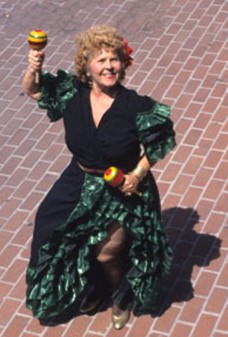Emelia Fernandez
1996 Florida Folk Heritage Award

Retired restaurateur Emelia Fernandez (b. 1935), affectionately known as the “Cuban Coffee Queen” to locals, led a comparsa dance group in Key West. She was born in the city of Central Chaparra, Cuba, where she learned the comparsa tradition and other dances from family and friends. She moved to Florida in 1959.
Comparsa means “stage company” or “masquerade group.” The dance, a Cuban tradition with African roots, is usually performed in long conga lines in the streets during public celebrations. Dancers dress in colorful, ruffled costumes and are accompanied by a band playing pulsing Afro-Cuban music. Sometimes comparsa takes the form of a parade or procession, with the band walking ahead of the whirling dancers. The music is largely percussive, employing a number of drums, bongos, congas, and timbales—as well as cowbells and skillets played with drumsticks. One or more trumpets or saxophones weave a melody line over the rhythm. Fernandez recalls that, when she was a girl in pre-Castro Cuba, each town or province had its own color for comparsa costumes, and there were competitions for the best dancing and for the group that could dance the longest without stopping.
The Key West comparsa tradition was established in 1938, when Abelardo Boza founded the original Cayo Hueso Comparsas. His group, nicknamed Los Dandys de Boza, flourished until his death in the early 1990s. Fernandez explained that her comparsa is a little different from Boza’s group and from that found in other Cuban communities. For example, the farolas (decorative lanterns) that she made with the help of a carpenter friend are lighter in weight and not illuminated. The farola poles are carried in cups on leather belts made for holding deep sea fishing rods. The cups enable the farolas to be spun constantly, thus increasing their visual effect. She also added group dance figures, such as arches and circles. In the 1990s, Fernandez and her daughter Irene visited Cuba several times, which reinforced their dedication to the comparsa tradition. “I like my roots,” she stated with conviction. “I want my roots to stay in Key West.”
To maintain the tradition, Fernandez assembled the Cayo Hueso Comparsa Dancers. She and Irene, who danced with Boza’s group, choreographed all the dances. The dancers performed with Danny Acosta’s Comparsa Band, a group of musicians that had played for Boza’s comparsa. Using old costumes from Irene and Danny as patterns, Fernandez designed and sewed all the costumes for the group members. Satin and organza trim were among the standard materials. She even made a costume outfit for her toddler granddaughter, who intended “to be a comparsa, too.”

